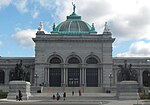Statue of Alexander von Humboldt (Philadelphia)
1871 establishments in Pennsylvania1871 sculpturesAlexander von HumboldtBronze sculptures in PennsylvaniaMonuments and memorials in Philadelphia ... and 5 more
Outdoor sculptures in PhiladelphiaSculptures of men in PennsylvaniaStatues in PennsylvaniaUse American English from September 2020Use mdy dates from September 2020

The Alexander von Humboldt statue is a monumental statue of Alexander von Humboldt in Philadelphia, Pennsylvania, United States. Located in Fairmount Park, the statue was completed in 1871 and donated to the city in 1876.
Excerpt from the Wikipedia article Statue of Alexander von Humboldt (Philadelphia) (License: CC BY-SA 3.0, Authors, Images).Statue of Alexander von Humboldt (Philadelphia)
MLK Drive Sidepath, Philadelphia
Geographical coordinates (GPS) Address Nearby Places Show on map
Geographical coordinates (GPS)
| Latitude | Longitude |
|---|---|
| N 39.98224 ° | E -75.20581 ° |
Address
Alexander von Humboldt
MLK Drive Sidepath
19129 Philadelphia
Pennsylvania, United States
Open on Google Maps











